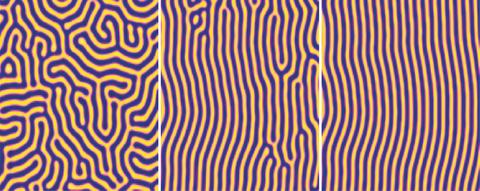Summary
Our goal is to develop critical measurement solutions that enable nanomanufacturing with template guided block copolymer assembly for next generation magnetic data storage, nanoscale electronics, and high efficiency membranes for energy. To achieve this goal, we are combining unique modeling platforms with precision thermal processing techniques to enable the development of small angle x-ray and neutron scattering to measure structural uniformity, including orientation distributions, and pattern placement in self-assembled polymer films within templated surfaces.
Description

Viable nanomanufacturing of templated block copolymers will require a capability to control orientation and line edge roughness of trillions of structures to within a single nanometer, however there are no existing platforms that meet this need. We are developing small angle x-ray and neutron scattering techniques to measure the orientation, orientation distribution, and pattern quality of block copolymers ordered on chemical and physical templates over large areas with high precision. These parameters are key to developing effective nanomanufacturing strategies. For example, NIST has developed a methodology to create large area block copolymer films with a highly preferred orientation. These samples are then suitable for characterization by small angle scattering to determine an orientation distribution indicative of pattern quality, including line edge roughness. This capability allows NIST and customers to provide powerful data on the relationship between materials, processing, template design, and the expected pattern quality.
Major Accomplishments
- The electronics industry, including data storage, has an estimated $7 trillion global impact, and is expected to be a primary driver for the US economy.
- The "Grand Challenges" of the International Technology Roadmap for Semiconductors demonstrate the lack of measurement solutions for pattern uniformity and pattern placement in dense arrays of sub-50 nm structures which are the foundation of next generation electronics and data storage.
- A NIST collaboration with IBM and Hitachi Global Data Storage has identified the distribution of orientation of self-assembled structures as a key indicator of pattern quality necessary for technology development.
- A new method for constructing nanopatterned samples developed at NIST has been incorporated by Micron Technologies for research into next generation DRAM manufacturing.

Block copolymers are materials that naturally self-assemble into monodisperse, chemically distinct domains, however their placement and orientation are difficult to control. Recent work has demonstrated a capability to utilize these domains as masks for pattern transfer and as functional materials for membranes. However, progress in the field is hindered by the lack of capability to probe the complex link between materials chemistry, process parameters, and the pattern quality. This year, our group has successfully developed techniques necessary to probe this unique class of materials with unprecedented precision and control.

Zone Annealing
The powerful role of thermal gradients was highlighted by the discovery of moving thermal zones, or "zone annealing", as a primary driver of enhanced kinetics in self-assembling block copolymer films. As shown in the figure above, the focused application of a local thermal field provides a surprising capability to quickly and uniformly generate large grains in block copolymer films. These samples are then ideal candidates for characterization with microscopy and small angle scattering. Self-consistent field theory provided the important link of directed thermal gradients as the primary mechanism for this effect. Ongoing work is investigating the relationship of materials chemistry on pattern quality, including line edge roughness (LER).

Rotational Small Angle Scattering
This year, we succeeded in developing a measure of the 3-dimensional orientation distribution in block copolymer films using Small Angle Neutron Scattering (SANS) and its X-ray analog (SAXS). The techniques are unique in their capability to measure films of arbitrary thickness, from monolayers commonly considered in microelectronic applications, to films of macroscopic thickness applicable in membrane technologies. The transmission scattering of the block copolymer film measured over a range of incidence angles provides the relative domain placement in all 3-dimensions.The small angle scan reveals structure that previously required a cross-sectional image from electron microscopy. Electron microscopy, however, is difficult to apply reliably in many block copolymers due to their susceptibility to beam damage. This information is used to provide details of the overall structure such as the average orientation and the orientation distribution of nanostructures. We reported this work via invited lectures at FY07 National and International meetings of the American Chemical Society, American Physical Society, and at a focused symposium on data storage at the Materials Research Society. In FY08, we will leverage this capability to explore the fundamental limits of pattern uniformity as a function of common processing and materials parameters.

